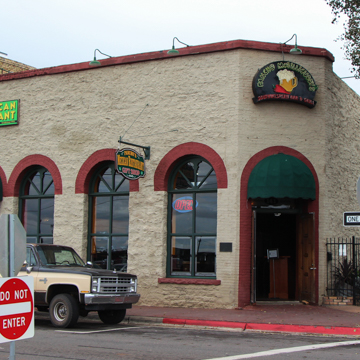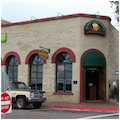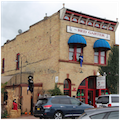Two of the oldest buildings in Williams are the Cabinet Saloon (built circa 1895) and the abutting Tetzlaff Building (1897). Both survived three fires due to their masonry construction and, in fact, the Tetzlaff’s brick walls are believed to have halted the spread of the 1903 fire that decimated Saloon Row (six businesses, one restaurant, and several shacks were lost). As the name of this block of West Railroad Avenue suggests, both buildings functioned as saloons and brothels that catered to the cowboys, railroad workers, and lumberjacks in the area. Local authorities didn’t outlaw gambling and prostitution until 1907, and Saloon Row flourished at the turn of the century.
Built by August Tetzlaff, a local merchant and tailor, the two-story Tetzlaff Building housed a gambling hall and a parlor on the first floor, eight “cribs” for prostitution on the second floor, and a Chinese restaurant and opium den in the rear. The Romanesque Revival commercial building is composed of buff-colored brick with sandstone belt courses. It features a highly decorative metal cornice dating to 1901 and foliated scrollwork above the second-story windows. On the ground level, a sandstone keystone marks the arched side entrance and a massive archway holds storefront windows; wooden, engaged columns flank the recessed entrance. Inside, the first floor features a tongue-and-groove wooden ceiling, hardwood floors, and wainscoting. Today the building is occupied by a bed and breakfast on the upper floor and a café on the ground floor.
Cormick E. Boyce, one of Williams’ most prominent businessmen and real estate developers, built the Cabinet Saloon. A one-story, rectangular building measuring approximately 94 by 28 feet, the saloon has two large rooms. The shed-roofed edifice is built of locally quarried dacite with brick trim. It is a loose interpretation of the Romanesque Revival style, with five arched windows on the facade, one of which has been converted into a side entrance. The main entry is on a chamfered corner that faces the intersection of two major streets, North Grand Canyon Boulevard (which becomes Second Street) and West Railroad Avenue (Historic Route 66). The interior features a pressed-metal ceiling, wood floors, and plastered walls clad in vertical wooden planks. Long used as a watering hole, the former saloon now houses a brewery; the interior was featured in a bar scene in the 1988 movie Midnight Run with actor Robert DeNiro.
References
Hoffman, Charles A., “Williams Historic Business District,” Coconino County, Arizona. National Register of Historic Places Registration Form, 1983. National Park Service, U.S. Department of the Interior, Washington, D.C.
Hoffman, Charles A., and P. Blystone, “Cabinet Saloon,” Coconino County, Arizona. Arizona State Historic Property Inventory, No. WMB-11, 1983. Arizona State Historic Preservation Office, Phoenix, Arizona.
Hoffman, Charles A., and J. O’Brien, “Tetzlaff Building,” Coconino County, Arizona. Arizona State Historic Property Inventory, No. WMB-12, 1983. Arizona State Historic Preservation Office, Phoenix, Arizona.




